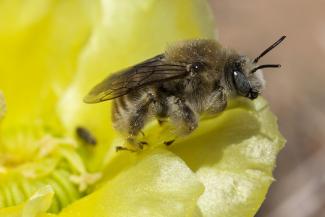
Image Credit: Patrick Alexander
Turret-building fuzzy bees: (Anthophoridae: Diadasia)
Though with numerous close relatives in the New World tropics, Diadasia is the only genus to make it to the Pacific Coast of California to Washington. Most of the American species (and many in South America as well) are specialists on the mallow/hibiscus family. In California, there are also specialists on morning-glory, cactus and sunflower. In Oregon, they are the primary pollinators of the “checkers” genera Sidalcea and Iliamna.
I have seen many sites in the southwestern deserts comprised of dozens to hundreds of individual nests, each usually with a prominent turret atop the actual burrow entrance burrow. In my long-term memory, Diadasia is forever linked with my studies in Chile. On my first trip to the Atacama Desert to establish research sites, I was standing beside the Pan-American Highway in the pea-soup dense morning sea-fog blowing in from the adjacent ocean observing clusters of male Diadasia sleeping in the Chilean desert mallow Sphaeralcea flowers. My observations were interrupted by a VW bus going 150 km/hr. on the highway screeching to a meandering stop and disgorging more than a dozen adults who descended upon me at a run (in the middle of truly nowhere)! One man, whom I had never met before, extended his hand in greeting and said “Dr. Moldenke, I presume. Please, let several of us ride in your vehicle and we will go to explore a locust plague several hundred kilometers to the north at an oasis that has never in recorded or verbal history ever had rainfall before!” This was the eminent bee-scientist, Haroldo Toro, to whom I had written to 6 months before, to acquaint him with my team’s research and my hope to work with him.


Super-fuzzy Diadasia bees in flowers of the mallow family (Malvaceae)(left). All species of Diadasia are specialist feeders, on several different types of host plants. The most unique characteristic of this group is the construction of turrets at their nest entrances (right).